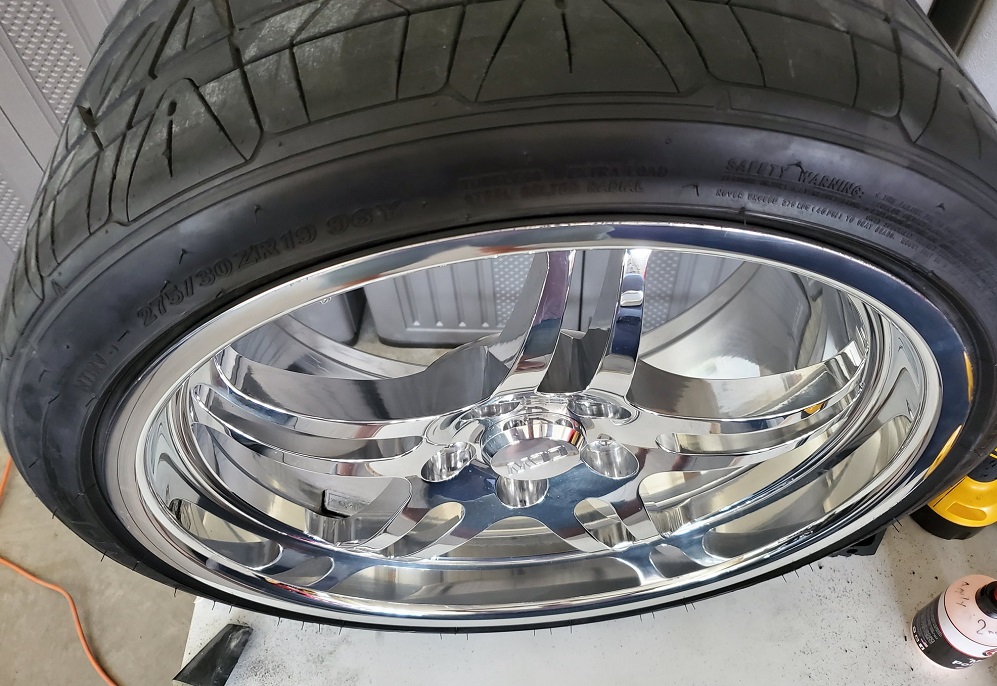Polished aluminum wheels, with their eye-catching brilliance, are a testament to the allure of automotive aesthetics. However, the journey to maintaining that pristine shine is not without its challenges. In recent years, ceramic coating has emerged as a revolutionary solution in the realm of car care, prompting enthusiasts to wonder: Can you ceramic coat polished aluminum wheels? In this comprehensive guide, we’ll not only answer this burning question but also explore the nuances of ceramic coating for wheel protection.
Understanding the Basics of Ceramic Coating
What Sets Ceramic Coating Apart?
Ceramic coating, often referred to as nano-coating, is a liquid polymer that forms a robust bond with a vehicle’s factory paint. This chemical fusion creates a protective layer that serves as a formidable shield against a myriad of environmental assailants, including UV rays, contaminants, and pollutants. But, can this technology truly complement the unique surface of polished aluminum wheels?
The Compatibility of Ceramic Coating with Polished Aluminum
Assessing the Surface: A Critical First Step
Before embarking on the ceramic coating journey, a meticulous assessment of the polished aluminum wheel surface is imperative. Addressing pre-existing issues, such as scratches or dings, is crucial as ceramic coating is not a remedy for these conditions.
Preparation Steps: The Foundation for Success
To ensure optimal results, meticulous preparation is key. Begin by thoroughly cleaning the wheels to eliminate dirt, brake dust, and any lingering residue. Polished aluminum surfaces must be pristine before the application of ceramic coating.
Steps to Ceramic Coat Polished Aluminum Wheels
1. Wheel Cleaning: The Starting Point
Initiate the process by cleaning the wheels with a gentle, pH-neutral cleaner. This step sets the stage for the removal of contaminants that might hinder the bonding process.
2. Decontamination: Achieving a Smooth Canvas
Utilize a clay bar to decontaminate the surface effectively. This step eliminates embedded contaminants, creating a smooth canvas that facilitates the ceramic coating’s adherence.
3. Polishing: Enhancing the Brilliance
Polishing the wheels not only contributes to a more effective bonding of the ceramic coating but also enhances the shine, addressing minor imperfections along the way.
4. Surface Activation: Ensuring Optimal Adhesion
Apply an alcohol-based solution to activate the surface, guaranteeing that the ceramic coating adheres optimally for lasting protection.
5. Ceramic Coating Application: Building the Protective Layer
Using an applicator pad, apply the ceramic coating evenly to the polished aluminum wheels. Allow it to cure for the recommended time, allowing a robust protective layer to form.
Advantages of Ceramic Coating on Polished Aluminum Wheels
1. Prolonged Shine: A Lasting Impression
Ceramic coating acts as a guardian, preserving the brilliant shine of polished aluminum wheels for an extended period, ensuring a lasting impression wherever the road takes you.
2. Protection Against Environmental Elements: Guarding Against Corrosion
The coating serves as an impenetrable barrier, shielding wheels from the corrosive effects of road salts, bird droppings, and other environmental contaminants.
3. Ease of Maintenance: Streamlining Cleaning Efforts
Cleaning becomes a breeze with the hydrophobic properties of ceramic coating, repelling water and contaminants and making maintenance a hassle-free affair. (See Also: How Many Spray Cans to Paint a Car Hood: A Comprehensive Guide)
Addressing Common Concerns
1. Heat Resistance: Withstanding High Temperatures
Ceramic coatings boast excellent heat resistance, making them an ideal choice for polished aluminum wheels exposed to the heat generated by braking systems.
2. Longevity: A Long-Term Investment
When applied and maintained properly, ceramic coating can last for several years, offering enduring protection against the elements.
DIY vs. Professional Application
Weighing the Options: Skill vs. Precision
While some automotive enthusiasts choose the do-it-yourself route, professional application ensures precision and expertise. Consider your skill level and the value you place on your wheels before making a decision.
Going Beyond: Additional Tips for Wheel Care
Regular Inspections
Periodically inspect your ceramic-coated wheels for any signs of damage or wear. Promptly address issues to maintain optimal protection.
Appropriate Cleaning Products
Use wheel cleaners that are compatible with ceramic coatings to avoid compromising the protective layer.
Avoid Harsh Conditions
While ceramic coatings are robust, minimizing exposure to extreme conditions can further extend their lifespan.
Expert Tips for Ceramic Coating Polished Aluminum Wheels
Polishing aluminum wheels to a brilliant shine is an art, and preserving that shine with ceramic coating is a science. As you embark on the journey of wheel protection, consider these expert tips to ensure your polished aluminum wheels stay gleaming for the long haul.
1. Timing is Everything
Before applying ceramic coating, ensure your wheels are completely dry. Moisture can hinder the bonding process, affecting the effectiveness of the protective layer.
2. Precision Application Matters
Take your time during the application process. Ensure even coverage, and don’t rush the curing time. Patience guarantees a more durable and uniform ceramic coating.
3. Invest in Quality Products
Choose a high-quality ceramic coating specifically designed for automotive use. Inferior products may not provide the desired protection and longevity.
4. Regular Maintenance is Key
While ceramic coatings offer extended protection, regular maintenance is still essential. Clean your wheels regularly using pH-neutral cleaners to preserve the coating’s integrity.
5. Mind the Temperature
Avoid applying ceramic coating in extreme temperatures. Optimal application conditions usually range between 50°F to 80°F (10°C to 27°C), ensuring the coating cures effectively. (See Also: What happens if you paint over epoxy? A Comprehensive Guide?)
6. Consider Professional Application
If you’re uncertain about the DIY process or seek perfection, consider professional application. Experts bring precision and experience to the table, ensuring a flawless finish.
7. Inspect and Address Promptly
Regularly inspect your ceramic-coated wheels for any signs of damage or wear. Addressing issues promptly helps maintain the protective integrity of the coating.
8. Opt for pH-Neutral Cleaners
When cleaning your ceramic-coated wheels, choose pH-neutral cleaners. Harsh chemicals may compromise the coating, diminishing its protective capabilities.
9. Avoid Automatic Car Washes
While convenient, automatic car washes often use harsh chemicals that can degrade ceramic coatings. Opt for hand washing to ensure gentle yet effective cleaning.
10. Mind the Brake Dust
Polished aluminum wheels are susceptible to brake dust. Regularly clean your wheels to prevent the build-up of corrosive contaminants that can compromise the coating.
By incorporating these expert tips into your ceramic coating regimen, you’ll not only protect your polished aluminum wheels but also elevate their shine to new heights. Remember, a little care goes a long way in maintaining the allure of your wheels on every journey.
Frequently Asked Questions About Ceramic Coating Polished Aluminum Wheels
Navigating the realm of ceramic coating for polished aluminum wheels may raise several questions. Here, we address some common queries to guide you on the path to optimal wheel protection.
1. Can I Apply Ceramic Coating to Any Polished Aluminum Wheels?
Absolutely! Ceramic coating is compatible with all types of polished aluminum wheels. However, ensure the wheels are in good condition before application.
2. How Long Does Ceramic Coating Last on Polished Aluminum Wheels?
With proper application and maintenance, ceramic coating can last for several years. Regular inspections and touch-ups enhance longevity.
3. Is Ceramic Coating Resistant to Brake Dust?
While ceramic coatings provide a barrier against contaminants, including brake dust, regular cleaning is still necessary to maintain the coating’s effectiveness.
4. Can I Use Any Wheel Cleaner on Ceramic-Coated Wheels?
It’s advisable to use pH-neutral wheel cleaners to preserve the integrity of the ceramic coating. Avoid harsh chemicals that may compromise the protective layer. (See Also: Can You Paint Lug Nuts? Tips for Stylish Wheels and DIY Lug Nut Painting)
5. Does Ceramic Coating Protect Against Scratches?
Ceramic coating offers some level of scratch resistance, but it’s not a cure for deep scratches. Address any existing scratches before applying the coating for optimal results.
6. Can I Drive Immediately After Applying Ceramic Coating?
While the initial cure time varies, it’s recommended to avoid driving for at least 24 hours after applying ceramic coating to allow it to fully bond with the wheels.
7. Do I Need to Reapply Ceramic Coating After a Certain Period?
Ceramic coatings are durable, but factors like environmental conditions and driving habits can affect longevity. Regular inspections will help determine if reapplication is needed.
8. Can I Apply Ceramic Coating in Extreme Temperatures?
Optimal application conditions are between 50°F to 80°F (10°C to 27°C). Avoid applying ceramic coating in extreme temperatures to ensure proper curing.
9. Can I Apply Ceramic Coating Myself, or Should I Seek Professional Help?
Both options are viable. If you’re confident in your skills, a DIY approach is possible. However, professional application ensures precision and expertise for a flawless finish.
10. Does Ceramic Coating Provide UV Protection for Polished Aluminum Wheels?
Yes, ceramic coating offers UV protection, preventing the sun’s rays from fading and damaging the polished surface of aluminum wheels.
Embarking on the journey of ceramic coating for polished aluminum wheels can be a transformative experience. These FAQs aim to address your concerns and empower you to make informed decisions about protecting and enhancing the allure of your wheels.
Conclusion
In conclusion, the answer to the question, “Can you ceramic coat polished aluminum wheels?” is a resounding yes. Embracing this advanced protective technology not only ensures the longevity of your wheels but also enhances their aesthetic appeal. By following the outlined steps and considering the advantages, you can make an informed decision that keeps your polished aluminum wheels shining bright on every journey. Remember, the road to impeccable wheels is paved with careful consideration and meticulous care.



